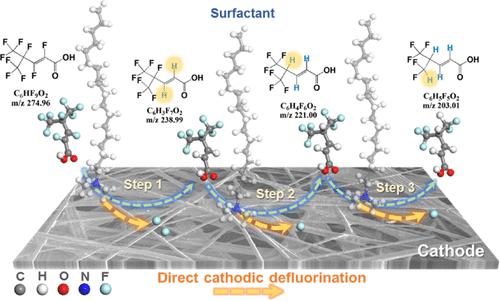当前位置:
X-MOL 学术
›
Environ. Sci. Technol.
›
论文详情
Our official English website, www.x-mol.net, welcomes your
feedback! (Note: you will need to create a separate account there.)
Electroreductive Defluorination of Unsaturated PFAS by a Quaternary Ammonium Surfactant-Modified Cathode via Direct Cathodic Reduction
Environmental Science & Technology ( IF 10.8 ) Pub Date : 2023-04-28 , DOI: 10.1021/acs.est.2c08182 Yue Wang 1 , Ye Xiao 1 , Yafei Wang 1 , Qingqi Lin 2 , Yanping Zhu 2 , Zhuobiao Ni 2 , Rongliang Qiu 1, 2
Environmental Science & Technology ( IF 10.8 ) Pub Date : 2023-04-28 , DOI: 10.1021/acs.est.2c08182 Yue Wang 1 , Ye Xiao 1 , Yafei Wang 1 , Qingqi Lin 2 , Yanping Zhu 2 , Zhuobiao Ni 2 , Rongliang Qiu 1, 2
Affiliation

|
Remediation of per- and polyfluoroalkyl substances (PFAS) in groundwater remains a technological challenge due to the trace concentrations of PFAS and the strength of their C–F bonds. This study investigated an electroreductive system with a quaternary ammonium surfactant-modified cathode for degrading (E)-perfluoro(4-methylpent-2-enoic acid) (PFMeUPA) at a low cathodic potential. A removal efficiency of 99.81% and defluorination efficiency of 78.67% were achieved under −1.6 V (vs Ag/AgCl) at the cathode modified by octadecyltrimethylammonium bromide (OTAB). The overall degradation procedure started with the adsorption of PFMeUPA onto the modified cathode. This adsorption process was promoted by hydrophobic and electrostatic interactions between the surfactants and PFMeUPA, of which the binding percentage, binding mode, and binding energy were determined via molecular dynamics (MD) simulations and density functional theory (DFT) calculations. The step-wise degradation pathway of PFMeUPA, including reductive defluorination and hydrogenation, was derived. Meanwhile, C–F bond breaking with direct electron transfer only was achieved for the first time in this study, which also showed that the C═C bond structure of PFAS facilitates the C–F cleavage. Overall, this study highlights the crucial role of quaternary ammonium surfactants in electron transfer and electrocatalytic activities in the electroreductive system and provides insights into novel remediation approaches on PFAS-contaminated groundwater.
中文翻译:

季铵表面活性剂改性阴极通过直接阴极还原对不饱和 PFAS 进行电还原脱氟
由于 PFAS 的微量浓度及其 C-F 键的强度,修复地下水中的全氟烷基物质和多氟烷基物质 (PFAS) 仍然是一项技术挑战。本研究调查了一种具有季铵表面活性剂改性阴极的电还原系统,用于降解 ( E)-perfluoro(4-methylpent-2-enoic acid) (PFMeUPA) 在低阴极电位。在十八烷基三甲基溴化铵 (OTAB) 修饰的阴极上,在 -1.6 V(相对于 Ag/AgCl)下,去除效率为 99.81%,除氟效率为 78.67%。整个降解过程从 PFMeUPA 吸附到改性阴极开始。表面活性剂和 PFMeUPA 之间的疏水和静电相互作用促进了该吸附过程,其结合百分比、结合模式和结合能通过分子动力学 (MD) 模拟和密度泛函理论 (DFT) 计算确定。推导了 PFMeUPA 的逐步降解途径,包括还原脱氟和氢化。同时,该研究首次实现了直接电子转移的C-F键断裂,这也表明PFAS的C═C键结构促进了C-F断裂。总的来说,这项研究强调了季铵表面活性剂在电还原系统中的电子转移和电催化活性中的关键作用,并提供了对 PFAS 污染地下水的新型修复方法的见解。
更新日期:2023-04-28
中文翻译:

季铵表面活性剂改性阴极通过直接阴极还原对不饱和 PFAS 进行电还原脱氟
由于 PFAS 的微量浓度及其 C-F 键的强度,修复地下水中的全氟烷基物质和多氟烷基物质 (PFAS) 仍然是一项技术挑战。本研究调查了一种具有季铵表面活性剂改性阴极的电还原系统,用于降解 ( E)-perfluoro(4-methylpent-2-enoic acid) (PFMeUPA) 在低阴极电位。在十八烷基三甲基溴化铵 (OTAB) 修饰的阴极上,在 -1.6 V(相对于 Ag/AgCl)下,去除效率为 99.81%,除氟效率为 78.67%。整个降解过程从 PFMeUPA 吸附到改性阴极开始。表面活性剂和 PFMeUPA 之间的疏水和静电相互作用促进了该吸附过程,其结合百分比、结合模式和结合能通过分子动力学 (MD) 模拟和密度泛函理论 (DFT) 计算确定。推导了 PFMeUPA 的逐步降解途径,包括还原脱氟和氢化。同时,该研究首次实现了直接电子转移的C-F键断裂,这也表明PFAS的C═C键结构促进了C-F断裂。总的来说,这项研究强调了季铵表面活性剂在电还原系统中的电子转移和电催化活性中的关键作用,并提供了对 PFAS 污染地下水的新型修复方法的见解。






























 京公网安备 11010802027423号
京公网安备 11010802027423号